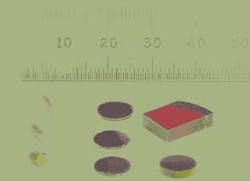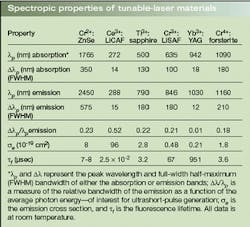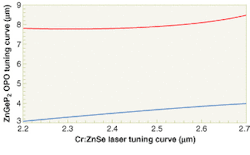The chalcogenide laser comes of age
TIMOTHY J. CARRIG
Broadly tunable near- and mid-infrared lasers are of interest for a variety of scientific, remote sensing, and military applications. These include high-resolution optical spectroscopy, metrology, pumping of nonlinear optical-frequency converters such as optical parametric oscillators (OPOs), standoff chemical sensing, optical communications through poor visibility conditions, and multispectral detection and imaging.
Tunable laser sources in the 2- to 3-µm region include chromium (Cr2+)-doped chalcogenide lasers, lasers based on cryogenic materials such as color-center lasers, limited-tunability systems such as thulium (Tm) lasers, gas or chemical lasers, semiconductor lasers, and nonlinear optical devices such as OPOs.1 Laser sources in the 3- to 4-µm band include the previously named sources, iron (Fe2+)-doped chalcogenide lasers, lead-salt-diode lasers, and nonlinear frequency mixers.
Transition-metal-doped chalcogenide lasers are of high interest because of their versatility, broad room-temperature wavelength tunability, demonstrated high optical efficiencies, potential for scaling to high powers via direct diode pumping, and relative novelty.2 Additionally, the materials can be produced by a variety of methods, including several direct-growth techniques and diffusion doping. Continuous-wave (CW), gain-switched, Q-switched, and modelocked laser operation has been demonstrated.
Material advantages include broad absorption and emission bands, high fluorescence quantum efficiencies at room temperature, moderate-gain cross sections, and minimal loss from excited-state absorption or upconversion. The principal disadvantages include a large change in refractive index with temperature (Δn/ΔT), and for some applications, a short fluorescence lifetime. The high Δn/ΔT can lead to strong thermal lensing, which complicates high-power laser designs. A short fluorescence lifetime limits the energy that the laser crystal can store and, consequently, the energy available for Q-switched pulses.
Material properties
The seminal work in this field, by Laura DeLoach and colleagues at Lawrence Livermore National Laboratory (Livermore, CA), provides a thorough discussion of the spectroscopic features of Cr2+, Fe2+, cobalt (Co2+), and nickel (Ni2+) ions in several zinc-chalcogenide hosts and presents the first laser results using chromium-doped zinc selenide (Cr:ZnSe) and chromium-doped zinc sulfide (Cr:ZnS).3 To date, laser action has been demonstrated using the Cr2+ and Fe2+ ions.
The Cr2+ ion has been doped into several binary and ternary II-VI semiconductors. The materials are similar to Ti3+:sapphire in that detrimental effects such as excited-state absorption are weak or nonexistent. The expected fundamental energy-state transitions are broadened because of coupling between the vibrational and electronic wave functions. At elevated temperatures (room temperature for the purposes of practical laser design), many vibrational energy levels are occupied. The vibrational fine structure is not resolved, and a single, wide, homogeneously-broadened absorption or emission peak is observed (see Fig. 1). These spectral features result in relaxed pump-wavelength constraints, and permit broad and continuous laser tuning.Diffusion-doped Cr:ZnSe crystals are prepared by sealing ZnSe wafers in a quartz ampoule with chromium selenide (CrSe) powder, heating to between 800°C and 1000°C for several hours to several days. Advantages to this process are its simplicity and the fact that relatively inexpensive polycrystalline window material can be used to produce laser rods. A disadvantage is that crystals have a spatially varying doping profile. This problematic profile can be improved by growing doped crystals using more traditional techniques such as Bridgman growth.
Chalcogenide laser crystals have fluorescence lifetimes on the order of several microseconds. Studies at Fisk University (Nashville, TN) and the Air Force Research Laboratory (Dayton, OH) involving Cr:ZnSe and Cr:CdSe, respectively, indicate that both materials suffer concentration-quenching effects when Cr2+ concentrations exceed approximately 1019 cm-3.
Important material advantages of Cr-doped chalcogenides include large emission cross sections, high-fluorescence quantum efficiencies at 300 K (enables efficient room-temperature laser operation), and high thermal conductivities (compare 18 Wm-1 K-1 for ZnSe with 14 Wm-1 K-1 for YAG). The spectroscopic properties of Cr:ZnSe compare favorably to those of other common tunable laser materials (see table).Cr:ZnSe laser work
The Cr2+:ZnSe laser has emerged as the most practical of all transition-metal-doped chalcogenide lasers. The laser has been operated in continuous-wave, Q-switched, and modelocked modes. Output powers on the order of 10 W have been generated at Coherent Technologies (CTI), with the laser crystal maintained at 40°C. Minimal cooling requirements are important in applications in which prime power and thermal management are concerns.
We have built lasers using Cr:ZnSe platelets, rods, and thin disks (see photo at top of this page). We have used 1.94-µm Tm:YAlO lasers and 1.58-µm NaCl:OH- color-center lasers as pump sources. Others have built chalcogenide lasers using 1.8- to 1.9-µm cobalt magnesium fluoride (Co:MgF2) lasers, 1.9- to 2.1-µm Tm and holmium (Ho) lasers, roughly 1.6-µm Raman-shifted Nd:YAG lasers, 1.6-µm erbium-fiber lasers and amplifiers, and 1.6 to1.8-µm indium gallium arsenide phosphide/indium phosphide (InGaAsP/InP) semiconductor lasers as pump sources.
Other laser geometries, such as zigzag slabs and planar waveguides, will become attractive if high-power 1.8-µm diode arrays become commercially available. Lack of these sources is a major stumbling block to widespread use of chalcogenide lasers. Despite this, several groups in the United States and Europe have demonstrated diode-pumped continuous-wave and pulsed Cr:ZnSe lasers. To date, however, output power levels have been limited to several hundred milliwatts.
The Cr:ZnSe laser generates continuously tunable light across most of the 2-to 3-µm spectral region. We have tuned a multiwatt output power Cr:ZnSe laser from 2.1 to 2.8 µm with linewidths on the order of 0.5 nm. Irina Sorokina and colleagues at the Technische Universität (Wien, Austria) have demonstrated a laser tuning from 2.0 to 3.1 µm.
The Cr:ZnSe laser is well suited for short-pulse generation. Work at CTI, in 1999, in collaboration with Cornell University (Ithaca, NY) and Koç University (Istanbul, Turkey) resulted in the first demonstration of a modelocked transition-metal-doped chalcogenide laser. This system produced transform-limited, Gaussian-shape pulses as short as 4.4 ps in duration. The laser was actively mode-locked using an intracavity acousto-optic modulator. The broad gain bandwidth of this laser should support the generation of subpicosecond pulses if intracavity dispersion-compensation schemes are used. In Q-switched mode, nanosecond-duration pulses have been generated.
Other chalcogenide sources
Other binary and ternary compound chalcogenide materials have been lased. These include Cr2+ lasers in the ZnS, CdSe, and chromium cadmium manganese tellurium (Cd1-xMnxTe) hosts. The Cr:ZnS host is of interest because of its lower Δn/ΔT than Cr:ZnSe, but similar absorption and emission properties. The CdSe host is attractive because Cr:CdSe fluoresces at longer wavelengths than Cr:ZnSe and excites at longer wavelengths (enabling use of a wider range of Tm- and Ho-laser pump sources). Additionally, the CdSe host is birefringent and has a high nonlinear susceptibility.
Consequently, single-crystal laser-OPO devices can use CdSe as the lasing and nonlinear medium simultaneously. Researchers at Hampton University (Hampton, VA) and Brimrose (Baltimore, MD) have investigated the ternary compound semiconductors as alternatives to the binary hosts. Varying the chemical composition and lattice parameter of the compound can optimize the optical properties of the ternary alloy. So far, Cr:CdSe and Cr:Cd1-xMnxTe have only lased in gain-switched modes, with tuning ranges of 2.45 to 3.40 µm and 2.17 to 3.01 µm, respectively.
Doubly ionized iron (Fe2+) is the only transition-metal ion other than Cr2+ to lase in a chalcogenide host. The Fe2+ ion has a complementary electronic structure to Cr2+ and a similar set of energy levels. The system is of interest because emission occurs from 3.7 to 4.6 µm. However, at room temperature, nonradiative decay quenches the emission. To date, the laser has only operated at cryogenic temperatures.
Chalcogenide lasers have matured enough to become useful for several applications. The most obvious is broadly tunable sources for high-resolution optical spectroscopy. Single-frequency operation is a straightforward extension of current technology. Such tools are useful in combustion studies or for short- and long-range monitoring of atmospheric gases such as water vapor and methane.
Recently, CTI and TRW Space and Technology Division (Redondo Beach, CA) used a Cr:ZnSe laser to perform reflectivity measurements on axicon mirrors used in high-power hydrogen fluoride chemical lasers. A turnkey metrology system is under development. At CTI, Cr:ZnSe lasers were used to build pump-tuned zinc germanium phosphate (ZnGeP2) and CdSe OPOs that simultaneously operate in both mid-wave infrared and long-wave infrared spectral regions (see Fig. 2). Both spectral bands are important because of the numerous hydrocarbons and other industrial chemicals with absorption features in these regions. We are developing these sources as transmitters for long-range differential-absorption lidar (DIAL) systems.As increasingly compact diode laser or fiber laser pump sources emerge, chalcogenide lasers will become more practical. Further application to scientific problems, chemical sensing, and remote sensing is expected, resulting in the transition of these lasers from curiosities to workhorse devices.
REFERENCES
- J. Hecht, The Laser Guidebook, 2nd ed., McGraw-Hill, Blue Ridge Summit, PA (1992).
- T. J. Carrig, J. Electron. Mat. 31, 759 (2002).
- L. D. DeLoach et al., IEEE J. Quant. Electron. 32, 885 (1996).
TIMOTHY J. CARRIG is senior research scientist and registered patent agent at Coherent Technologies, 655 Aspen Ridge Dr., Lafayette, CO 80026; e-mail: [email protected].



